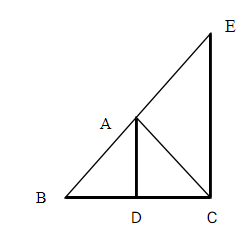
Prove that in a triangle, the angle bisector divides the side opposite to the angle in the ratio of the remaining sides.
Answer
549.3k+ views
Hint: To prove this, we have to use Basic Proportionality Theorem known as Thales Theorem. According to this theorem, if a line is drawn parallel to one side of a triangle intersecting the other two sides in distinct points, then the other two sides are divided in the same ratio.
Complete step-by-step answer:
Let $\Delta ABC$ be the triangle.
Let AD be the internal bisector of $$\angle BAC$$ which meet BC at D.

Step1:To prove: $$\dfrac{{DC}}{{BD}} = \dfrac{{AC}}{{AB}}$$ , draw $$CE\left | \right |DA$$ to meet BA produced at E.(as per above figure)
Step2:Since $$CE\left | \right |DA$$ and AC is the transversal.
$$\angle DAC = \angle ACE$$ ( alternate angle ) .... (1)
$$\angle BAD = \angle AEC$$ ( corresponding angle ) .... (2)
Step3:Since AD is the angle bisector of $$\angle A$$ ,
$$\angle BAD = \angle DAC$$ …...... (3)
Step4:From (1), (2) and (3), we have
$$\angle ACE = \angle AEC$$
Step5: In $\Delta ACE$ ,AE=AC as $$\angle ACE = \angle AEC$$ (as Sides opposite to equal angles are equal)
Step6:
In $\Delta BCE$,
$$CE\left | \right |DA$$
So, by Thales Theorem, $$\dfrac{{DC}}{{BD}} = \dfrac{{AE}}{{BA}}$$
Then $$\dfrac{{DC}}{{BD}} = \dfrac{{AC}}{{AB}}$$ (as AE =AC)
Hence, the angle bisector of a triangle divides the side opposite to the angle in the ratio of the remaining sides.
Note: Basic Proportionality theorem was introduced by a famous Greek Mathematician namely Thales. Hence it is also called Thales Theorem. According to him, for any two equiangular triangles, the ratio of any two corresponding sides is always the same. Based on this concept, he gave a theorem of basic proportionality. This concept has been introduced in similar triangles. If two triangles are similar to each other then,
i) Corresponding angles of both the triangles are equal.
ii) Corresponding sides of both the triangles are in proportion to each other.
Complete step-by-step answer:
Let $\Delta ABC$ be the triangle.
Let AD be the internal bisector of $$\angle BAC$$ which meet BC at D.

Step1:To prove: $$\dfrac{{DC}}{{BD}} = \dfrac{{AC}}{{AB}}$$ , draw $$CE\left | \right |DA$$ to meet BA produced at E.(as per above figure)
Step2:Since $$CE\left | \right |DA$$ and AC is the transversal.
$$\angle DAC = \angle ACE$$ ( alternate angle ) .... (1)
$$\angle BAD = \angle AEC$$ ( corresponding angle ) .... (2)
Step3:Since AD is the angle bisector of $$\angle A$$ ,
$$\angle BAD = \angle DAC$$ …...... (3)
Step4:From (1), (2) and (3), we have
$$\angle ACE = \angle AEC$$
Step5: In $\Delta ACE$ ,AE=AC as $$\angle ACE = \angle AEC$$ (as Sides opposite to equal angles are equal)
Step6:
In $\Delta BCE$,
$$CE\left | \right |DA$$
So, by Thales Theorem, $$\dfrac{{DC}}{{BD}} = \dfrac{{AE}}{{BA}}$$
Then $$\dfrac{{DC}}{{BD}} = \dfrac{{AC}}{{AB}}$$ (as AE =AC)
Hence, the angle bisector of a triangle divides the side opposite to the angle in the ratio of the remaining sides.
Note: Basic Proportionality theorem was introduced by a famous Greek Mathematician namely Thales. Hence it is also called Thales Theorem. According to him, for any two equiangular triangles, the ratio of any two corresponding sides is always the same. Based on this concept, he gave a theorem of basic proportionality. This concept has been introduced in similar triangles. If two triangles are similar to each other then,
i) Corresponding angles of both the triangles are equal.
ii) Corresponding sides of both the triangles are in proportion to each other.
Recently Updated Pages
The height of a solid metal cylinder is 20cm Its r-class-10-maths-ICSE

If a train crossed a pole at a speed of 60kmhr in 30 class 10 physics CBSE

Name the Writs that the High Courts are empowered to class 10 social science CBSE

A tower is 5sqrt 3 meter high Find the angle of el-class-10-maths-CBSE

Immediate cause of variations of A Mutations B Environmental class 10 biology CBSE

A rectangular container whose base is a square of side class 10 maths CBSE

Trending doubts
Why is there a time difference of about 5 hours between class 10 social science CBSE

Why is Sardar Vallabhbhai Patel called the Iron man class 10 social science CBSE

Tropical deciduous trees shed their leaves in the dry class 10 social science CBSE

The Equation xxx + 2 is Satisfied when x is Equal to Class 10 Maths

Write a letter to the principal requesting him to grant class 10 english CBSE

Leap year has days A 365 B 366 C 367 D 368 class 10 maths CBSE




